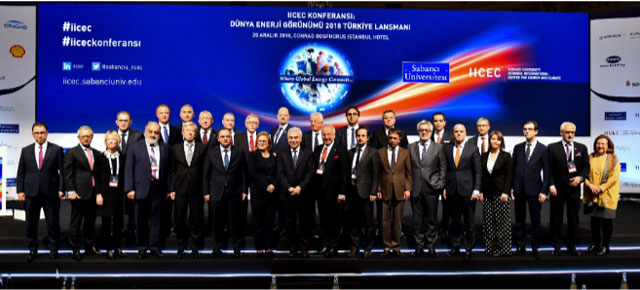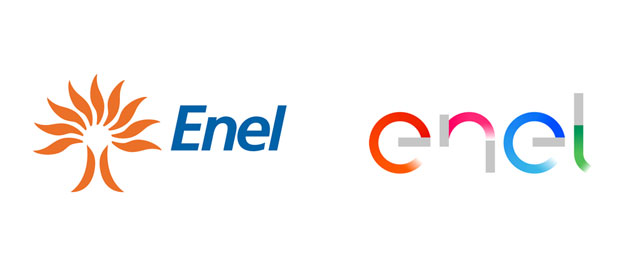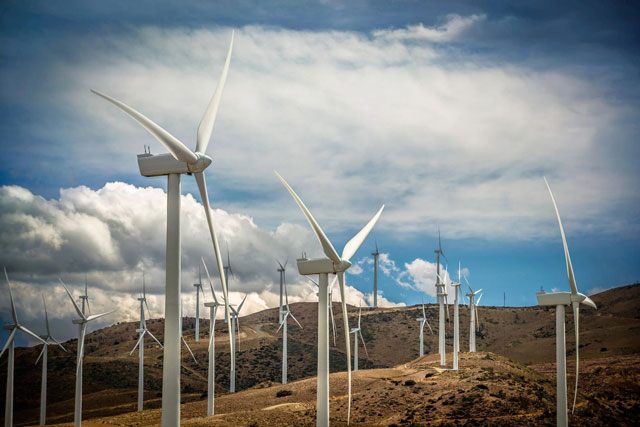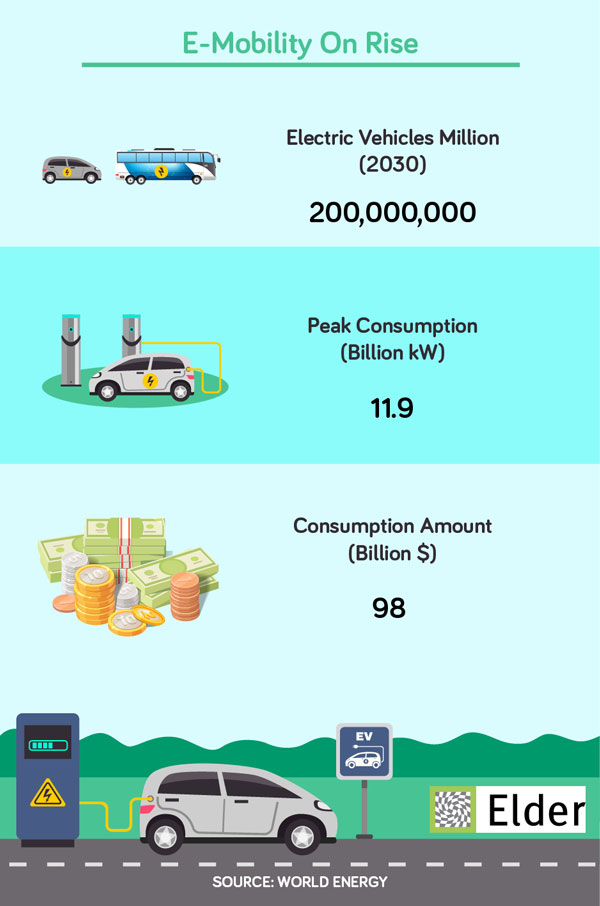
Turkey determines its own energy road map by searching on current technologies, artificial intelligent, smart systems, electric cars and block chain, Turkey’s Energy and Natural Resources Minister Fatih Donmez said.
Donmez, in his message to IICEC Annual Energy Conference featuring World Energy Outlook 2018 Turkey Launch, said that energy efficiency is a top issue for Turkey and efficiency is the cleanest source of all.
He also said renewable energy sources are growing in Turkey’s energy portfolio but their intermittency due to the weather conditions bring dilemma.
“We, in line with our National Energy and Mining Strategy, prioritize local production of renewable energy equipment with the aim of having the technology of renewable energy. Turkey aims to become renewable energy and storage technologies thanks to Renewable Energy Resources Zones projects,” he concluded.
- Emission increase hit record in 2018
IEA Head Fatih Birol, in his speech focusing on the WEO 2018, said that the biggest winners in energy sector are renewable energy resources especially led by solar and wind.
He said renewable energy resources contribute to the fight against climate change however realizing the climate targets is becoming more difficult.
“Carbon emissions see record increase in 2018 and the gap between the reality and the targets is growing,” Birol said.
“The biggest part of the problem is already with the existing energy infrastructure and facilities as they will be producing 95 percent of the emissions till 2040,” he explained.
Guler Sabanci, Founding Chairman of the Board of Trustees Sabancı University, pointed out to Turkey’s growing energy production capacity and diversity in the recent years.
Renewable and domestic resources are also growing in Turkey’s energy portfolio and renewable sources are among the most important topics in terms of low carbon growth and future, Sabanci underlined.
Kivanc Zaimler, Sabanci Holding Energy Group Head, said that energy sector is going through a very significant transformation.
“Considering the young population, urbanization and consumption habits, Turkey’s per capita electricity consumption is still half of that in Europe. Thus, there is an important growth potential in the sector,” he said.
On the other side, Zaimler said that Turkey should take some steps for creating financial sustainability.
“Turkey carried out $105 billion investment in energy almost in the last decade but $52 billion of this investment is indebted. Thus, we now face the problems of a flawy capital structure,” he stated.
He said the sector should have efficiency not only in terms of sources and consumption but also transmission, distribution and each circle of the value chain.
Source: IICEC

General Manager of Enerjisa Distribution Companies acting under Sabanci Holding of Turkey, Murat Pinar, was elected president of the EUROGIA2020 for the second consecutive time.
Pinar, acting as the president of EUROGIA2020 since July, 1, 2018, will start its second term by July,1, 2019.
Pinar, expressing his satisfaction thanks to his being elected again, said that believes his presidency will contribute both to EUROGIA2020 and also Turkey.
“We will continue to support R&D projects to reach our goals,” he said.
EUROGIA2020 is one of the EUREKA cluster projects, each involding many large and small European companies seeking to strengthen European competitiveness in key technology areas.
EUROGIA2020 encourages cooperation and coordination among European companies by promoting development of low carbon energy technologies.
EUROGIA2020 is a complementary to existing European and national programmes and offers the route to fast market growth through European cooperation.

The Enel Group has unveiled a one billion new green bond in Europe which will fund the firm's renewable energy, smart grid, smart metering, sustainable mobility, smart lighting, energy efficiency and demand response projects.
The development is part of the energy company's financial strategy set out in the 2019-2021 Strategic Plan.
The financial strategy includes investing up to 13.6 billion Euros to enhance operations through to 2021.
The one billion green bond is Enel's third in the European market.
The bond will be listed on regulated markets Irish Stock Exchange, Luxembourg Stock Exchange and on multilateral trading facility ExtraMOT PRO.
To date, the transaction has received subscriptions amounting to more than 4.2 billion Euros. with the significant participation of Socially Responsible Investors, enabling the Enel Group to continue to diversify its investor base.
The bond is expected to help Enel to achieve goals set at the 2017 Paris Climate Finance Day and the 17 Sustainable Development Goals (SDGs) of the United Nations.
The targets include ensuring 2.5 million beneficiaries of quality education between 2015 and 2030, 10 million beneficiaries of access to clean energy between 2015 and 2030, 8 million beneficiaries in terms of employment and sustainable and inclusive economic growth between 2015 and 2030.
The firm plans to install 46.9 million smart meters by 2021, invest 5.4 billion Euros in digitalisation capital expenditure in 2019-2021 and and deploy 455,000 public and private charging points installed by 2021.
Source: Smart Energy

The World Bank Group launched its Action Plan on Climate Change Adaptation and Resilience under which the Group will ramp up direct adaptation climate finance to reach $50 billion between 2021-2025.
This financing level - an average of $10 billion a year - is more than double what was achieved during 2015-2018.
The World Bank Group will also pilot new approaches to increasing private finance for adaptation and resilience.
"Our new plan will put climate resilience on an equal footing with our investment in a low carbon future for the first time. We do this because, simply put, the climate is changing so we must mitigate and adapt at the same time,” said World Bank Chief Executive Officer Kristalina Georgieva.
“We will ramp up our funding to help people build a more resilient future, especially the poorest and most vulnerable who are most affected,”she said.
The increase in adaptation financing will support activities that include delivering higher quality forecasts, early warning systems and climate information services to better prepare 250 million people in at least 30 countries for climate risks, supporting 100 river basins with climate-informed management plans and/or improved river basin management governance, building more climate-responsive social protection systems; and supporting efforts in at least 20 countries to respond early to, and recover faster from, climate and disaster shocks through additional financial protection instruments.
In addition to boosting finance, the plan will also support countries to mainstream approaches to systematically manage climate risks at every phase of policy planning, investment design, and implementation.
Sourced: World Bank

The annual UK energy satisfaction survey carried out by Which? Covered 30 suppliers in Great Britain and all seven in Northern Ireland capturing the experiences of 7,429 energy customers who told what they really think of the service they receive.
As well as rating the 'Big Six' energy suppliers - British Gas, EDF Energy, Eon, Npower, SSE and Scottish Power - Which? also investigate smaller companies.
This includes Bulb Energy, Co-operative Energy, First Utility, Octopus Energy, Ovo Energy and Utility Warehouse. Just one energy company earned the prestigious Which? Recommended Provider Award: Octopus Energy.
Which? asked 7,429 Great Britain energy customers to rate their energy suppliers’ customer service (both online and over the phone), how they deal with complaints, their value for money, the accuracy and clarity of bills, and whether they feel the company helps them to understand and reduce their energy use.
As a result of the survey, Octopus Energy had the highest rate with 80 percentage while Solarplicity had the lowest rate with 44 percentage.
Source: Which

Non-hydroelectric renewable energy resources such as solar and wind will be the fastest growing source of U.S. electricity generation for at least the next two years, according to the U.S. Energy Information Administration.
EIA's January 2019 Short-Term Energy Outlook forecasts that electricity generation from utility-scale solar generating units will grow by 10 percent in 2019 and by 17 percent in 2020, while wind generation will grow by 12 percent and 14 percent during the same period.
According to the agency, the share of total U.S. electricity generation produced by all renewables other than hydropower will increase by three percentage points during the next two years, going from 10 percent of total generation in 2018 to 13 percent in 2020.
"This projected growth is a result of new generating capacity the industry expects to bring online," the agency said, adding about 11 gigawatts (GW) of wind capacity is scheduled to come online in 2019, which would be the largest amount of new wind capacity installed in the U.S since 2012. An additional 8 GW of wind capacity is scheduled to come online in 2020.
EIA expects electricity generated from wind to surpass hydropower generation this year. "The share of total U.S. generation from wind is projected to increase from 7 percent in 2018 to 9 percent in 2020," it said.
According to the outlook, solar is currently the third-largest renewable energy source in the U.S. power sector, having surpassed biomass in 2017.
The sector plans to add more than 4 GW of new solar capacity in 2019 and almost 6 GW in 2020, the EIA said. This marks a total increase of 32 percent from the operational capacity at the end of 2018.
"Because of this increase, solar is forecast to contribute slightly more than 2 percent of total utility-scale generation in 2020," it added.
According to the EIA, in addition to utility-scale solar in the electric power sector, some residences and businesses have installed small-scale solar photovoltaic systems to supply some of the electricity they consume.
The agency forecasts that small-scale solar generating capacity will grow by almost 9 GW during the next two years, marking an increase of 44 percent.
Fossil fuels continue to be major source
Despite the growth from renewable energy sources, fossil fuels will still provide most of the electricity generated in the U.S., according to the outlook.
Coal and natural gas combined provided 63 percent of electricity generation in 2018 and EIA forecasts that they will provide 61 percent in 2020.
According to the agency, natural gas fueled 35 percent of total U.S. electricity generation in 2018, up from 24 percent in 2010.
"In contrast, the share of total generation from coal-fired power plants fell to 28 percent last year from 45 percent in 2010," the EIA said, adding the natural gas generation share is forecast to grow to 37 percent by 2020 while coal is expected to continue declining to 24 percent by 2020.
According to the outlook, coal was the predominant source of electricity generation fuel in the U.S. until 2016, when annual electricity generation from natural gas-fired power plants surpassed coal-fired generation.
"Since then, natural gas has remained the primary source of electricity," the EIA said, citing environmental regulations that led to retiring or modifying U.S. coal power plants, as well as the sustained low cost of gas and the increased overall efficiency of the natural gas power plant fleet as the main drivers behind the electric power sector's switch to natural gas from coal.
Source: AA
World Energy Insights Brief / 2018
The use of blockchain technology within the energy sector (“energy blockchain”) is emerging as a key strategy and focus area for modernisation of the industry. As a distributed ledger technology (DLT), blockchain provides a platform for the management and transaction of high-value data. Unlike other DLTs, however, blockchain is “trustless”1, requiring no intermediaries and, thus, it brings the potential to catalyse the existing business processes as well as a reduction of the overhead costs and level of complexity embedded in the current energy ecosystem.
Please click here to read the full report.
Distributech Conference & Exhibition
February 5 -7 / New Orleans
E-world Energy & Water 2019
February 5 – 7 / Germany
10th Energy Efficiency Forum And Exhibition
March 28 – 29 / Turkey
ICSG Istanbul 2019
April 25 – 26 / Turkey
EU Sustainable Energy Week (EUSEW) 2019
June 17 – 21 / Belgium

